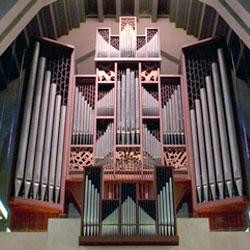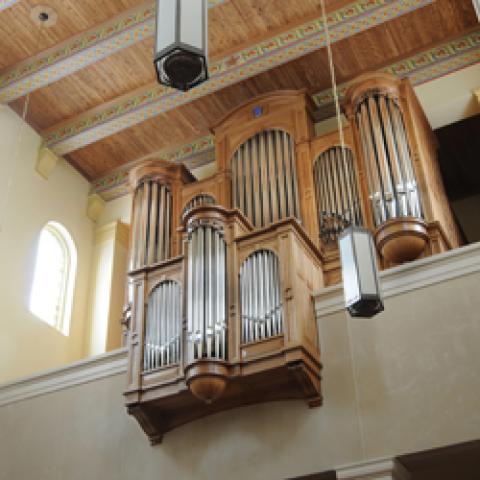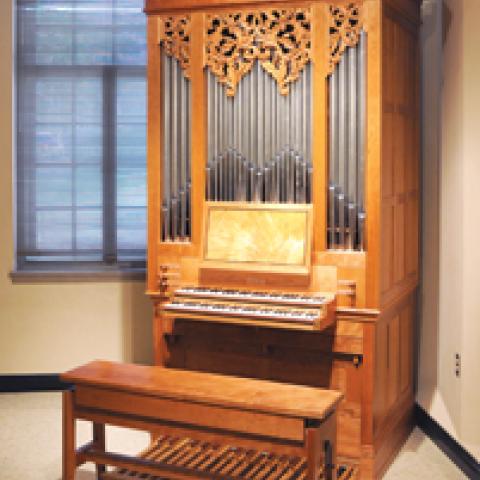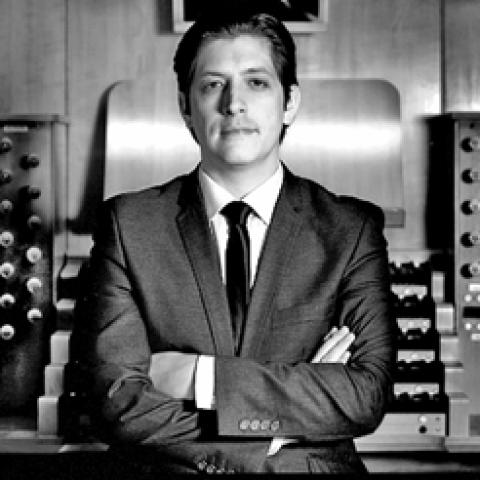Juget-Sinclair Organbuilders, Montréal, Québec, Canada
St. Joseph’s Oratory, Montréal, Québec, Canada
From the builder
The idea to fully restore the Beckerath organ at St. Joseph’s Oratory came from then Organist Titulaire Philippe Bélanger. We came up with different proposals, some involving changes to the instrument, some not, but for the moment we were firmly in the world of the hypothetical; no harm in talking about changes to the instrument—it was only a mental exercise then. Any thought that this might actually occur was accompanied by cold sweat and sleeplessness—after all, perhaps no other instrument has had a greater influence on organ building in Québec, and its influence has been worldwide.
Eventually, to our great relief, the authorities at St. Joseph’s Oratory wisely came to the conclusion that an outside expert and a proper bidding process were required. George Taylor was hired, deus ex machina, and three Québec companies were asked to bid on a very thorough RFP that specified no changes to the tonal specification. “No changes” may seem an obvious requirement, but it is not. Most musicians sitting at the console are soon surprised by what seems missing from the specification, despite its 78-stop, 5-manual footprint. But any thought of making changes leads straight to dilemma.
One example is instructive: the idea had naturally surfaced to add a trumpet to the Récit (yes, a 78-stop instrument with French pretensions and no Trompette on the Récit!). Now, how to add it—it could be added to the back of the chest grid; that way no one could complain about any stop being removed. Or, the Musette 4′ could be removed and replaced with a trumpet. The Musette could be racked mute on a wall in the swell box, for its own protection. I was amused by these two possibilities—the first pleases the musician at the console, who finds the original specification intact—plus, it provides the trumpet they always needed. The second pleases the restorer 50 years (or more!) from now, who finds a windchest that has not been denatured by holes bored through the frame to accommodate the extra toe board, and inevitably returns the Musette to its toe holes.
This dilemma cannot be resolved and let us not pretend it can. Any restoration, no matter how respectful, will remove some original material. In a museum setting, an ancient clavichord may be copied rather than restored so that the original continues to exist, unmolested, as a document for future generations. The copies allow musicians to play instruments that are as close as possible to the originals and to be informed by the experience. This is clearly not an option for organs, and to add to the conundrum, they exist primarily to accompany a changing liturgy. Organs occupy a strange space somewhere between typewriter and violin—between pragmatism and art—actually both at once.
But surely this is not of concern for an instrument of only 50 years? What made this project difficult to define in the early stages? In a way, it was an organ of conflict—wonderful to play, a beast to play; the specification is huge, but with huge holes; it is a historic monument, but only 50 years old. There are organbuilders the world over who consider themselves the spiritual sons of Rudolf von Beckerath, and the torchbearers of his tradition. The tension created by these issues made the appointment of George Taylor, outside expert, a stroke of genius that perhaps made the project the success that we believe it is.
It was decided to make no changes to the musical qualities of the instrument, but to rebuild the key action completely. If a line can be drawn in an organ between the musical and the mechanical, it is surely at the pallet itself, and this became an important distinction. In this instrument, the pallet openings on all divisions are unnecessarily wide—up to 30 mm with only 5 mm of travel at the nose, a terribly inefficient design, if efficiency is what you are after. Naturally, the question arose whether or not to change the pallet design—to provide as much or perhaps more wind and reduce pluck at the same time. But inevitably, the nature of the pipe attack would be changed, even if the quantity of wind was not. It was decided that in order to preserve the musical integrity of the instrument, the pallet dimensions should not be altered. This made for an interesting case study—without reducing pluck, to what extent could the action be made more agreeable to play, with up to four manuals coupled? The action, as we found it, was slow to repeat, but the spring force felt at the keyboard was nearly right. By reducing mass in the action train, we would be able to improve repetition, but the pluck would not be greatly reduced. Would musicians find the action to be improved, and if so, by how much?
A complete rebuild of the action was undertaken, using the tools available to us: reduce mass, reduce friction, and ensure proper functioning of all the elements. New roller boards were built for the Grand-Orgue, Récit, Bombarde, and Positif divisions. This was perhaps responsible for the greatest reduction in action mass; the original design follows laws of physics that we apparently no longer have access to. The mass of the rollers was adding a lot of inertia to the action, but there was also friction and flexibility. All trackers were replaced with carbon fiber—1 mm rod for vertical runs and ½ x 3mm section for horizontal runs. This material, as well as being very light and strong, has the benefit of remaining straight, so alignment is easy. But we did notice a tendency for people to think that as long as carbon fiber was involved, success was ensured. In reality, it is a material, like any other, whose qualities need to be understood for success.
The organ was first stripped of its action, and the console was removed and taken to the shop. There was a feeling of revisiting 1960 at this stage. We found cheeks on the sides of the console that clearly had held a sling used to hoist the console up over the gallery rail. The hole in the ceiling was still there, at the perfect location, ready for us to run a heavy rope through, and the console was soon lowered to the floor of the nave and brought to the shop. Then, restoration continued with two teams, one at the shop restoring the console and building new action parts, the other on site restoring windchests and pipework.
Restoration of each division of the organ was undertaken one after another, starting at the top with the Récit. Pipes were removed and taken to be cleaned and straightened in the chapelle des familles. This soundproof room just below the organ loft is intended for crying babies and their parents during Mass—ideal for pipe restoration, and roomy enough for a fairly complete pipe shop. At the same time, the Récit windchests were turned over and restored in place. This top-to-bottom approach allowed us to break a large instrument into manageable chunks, and had the additional benefit of allowing any dust we created to settle below, to the next division scheduled for restoration.
Particular attention was paid to the console, as it had lost the stark Germanic austerity—apparently not held in much esteem in the intervening years—that now seems oddly exotic. The original plastic stopknobs had long ago been replaced, so new maple ones were made, copying examples from the other Montréal Beckeraths. A sequencer was added, as were divisional pistons, using the same unorthodox arrangement found on the 1963 Beckerath in Pittsburgh—with inter-manual divisionals placed at e-f and b-c, between the sharps. Holes had been cut into the stop jambs over the years to accommodate various versions of instantly obsolete combination action. These were filled and veneered with matching pear wood. The goal was to restore and update the console so that future additions to the combination action would not deface the console. To this end, Solid State Organ Systems provided touch screen functionality via a wireless iPad, so that future changes can be handled here.
The five largest pipes of the Grand-Orgue Montre 16′, visible in the large central pipe flat, had been repaired once and collapsed twice since 1960. It was decided that new pipes were needed, built with knowledge reacquired since 1960, of how to make pipes that will stand. The rest of the tin façade pipes were removed, cleaned, repaired, polished, and returned to their holes. The twelve façade pipes that make up the first octave of the Pédale Montre 32′ are of zinc, and were cleaned in place. The entire operation required full scaffolding in front of the façade, which provided a clear signal to the public that a major project was underway.
Winding to the Montre 16′ was originally provided pneumatically to the bottom five pipes of the stop, to reduce wind demand on the channel. We continued this practice through the rest of the first octave, as there was considerable robbing going on, starting from F. Surprisingly, we had never heard complaints about this, but we were sure that if it was not improved, we would. New pneumatic offset chests were constructed following the design of the old one, which functions perfectly.
Voicing was undertaken in a spirit of respect for the builder. Sunken languids were raised, speech problems were taken care of, and stops were equalized, but every effort was taken to stay true to the intent of the builder. After pipes were straightened and cleaned, voicing was checked on a voicing jack before returning the pipes to their chests. Racking and pipe stays were improved and solidified where needed, but in general this had been well done originally. Façade pipes in danger of recollapse were relieved of about half of their weight by hanging them from springs, and should be safe now.
Reaction to the restoration has been very positive, to our great pleasure and even relief, but it has also been instructive. Musicians tend to feel that the voice of the organ has changed—not for the worse—but we are quick to stress that every effort was taken not to change the voicing one iota. But we’ve seen this before—the simple act of removing dust from an instrument changes its timbre. And we wonder if something else isn’t at work: the action is so changed that one’s approach to playing the instrument is different, and it does sound different—it can be more virile, and it sounds more precise, because it can be played more precisely.
In our work building new organs, Juget-Sinclair started with small instruments and has slowly grown, taking on larger and larger work. This restoration has given us the opportunity to take on a major instrument with new challenges of design and infrastructure. The success of this project fills us with confidence for the future, and we feel validates our approach of maintaining a small shop that builds as much as possible in-house. The variety of skills that we are able to foster through this approach serves us particularly well in restoration, where one never knows what challenges will arise. And we hope, in an ever-shrinking new organ market, that this is a model that will keep us occupied for some time.
The following participated in the restoration, which amounted to over 8,000 hours of work: Jocelyn Bélair, Robin Côté, François Couture, Dean Eckmann, Jean-Dominique Felx, Denis Juget, Céline Richard, Stephen Sinclair, Raymond Batroussy, Arnaud Duchenaux, Richard Houghten, and Vladimir Vaculik.
—Stephen Sinclair
A musician’s perspective
In spite of widespread secularization in Québec during the quiet revolution of the sixties, the attendance of about 50,000 Québecers at the celebration of the canonization of Brother André Bessette in Montréal’s Olympic Stadium on October 30, 2010 underscored the extent to which he is still very much this city’s beloved son. Shortly after making profession as a monk with the Congregation of the Holy Cross in Montréal in 1874, Brother André became a doorman at the College of Notre Dame. In the ensuing years, healings attributed to his prayer and intercession quickly gained for him a reputation as a faith healer. Increasing numbers of congregants drawn by the “Miracle Man of Montréal” quickly outgrew the small chapel he had erected in 1904 on the north slope of Mont Royal. The building of the current basilica commenced in 1924 and was completed in 1967. Today, St. Joseph’s Oratory stands as a towering testament to the life of this humble brother and is a prominent destination for pilgrims, tourists, and music lovers alike.
Given the oratory’s importance in the life of Montréal from its earliest days, the organ that was to be built here was going to have great civic importance from the outset. And given the immense grandeur of this sanctuary, the instrument would be of monumental proportion. After bids were considered, the fathers of the Congregation of the Holy Cross sent a letter on February 25, 1958 to Rudolf von Beckerath that he had been awarded the contract for the construction of the basilica organ. The contract was signed on June 23 of the same year and the builder was committed to deliver an organ within thirty months. Shortly thereafter, Beckerath submitted a design and several sketches. Among the various requests, Raymond Daveluy, titular organist, requested alterations to the stoplist that would allow the playing of a Récit de tierce, and the architects requested that the case embody more vertical lines. In early 1960, 167 crates arrived by sea, and installation commenced. The inaugural recital was given by Parisian organist André Marchal on November 13, 1960. The opening piece, Bach’s Prelude and Fugue in D Major, was played by Raymond Daveluy. Marchal followed with a program featuring the works of Louis and François Couperin, Clérambault, Daquin, and Tournemire. He also played de Grigny’s Tierce en taille, Franck’s Choral No. 3, Bach’s Fantasy and Fugue in G Minor, Langlais’ Te Deum, and ended the program with an improvisation.
That the building of the oratory organ would be entrusted to a German firm and not to Casavant Frères was a shock to the nationalist sensibilities of many. Coming only thirteen years after the war in which Québecers were conscripted to fight against Germany, this decision unleashed quite a firestorm in the Québec media of the day. However, there was a growing sense among many North American organists and musicians in the 1950s that the organ reform—as it was manifest in the work of Harrison, Holtkamp, and also Casavant Frères during the postwar period—did not go far enough in restoring principles of organ construction from the seventeenth and eighteenth centuries. Many of these young organists became familiar with organ reform in Holland and Germany on their European journeys.
Then in 1957, Rudolf von Beckerath installed a 44-stop, four-manual instrument in Trinity Lutheran Church in Cleveland, Ohio. The instrument featured a freestanding case designed according to the werkprinzip, mechanical key and stop action, lower wind pressure, and classical voicing inspired by the instruments of Arp Schnitger. While in North America, Beckerath paid a visit to Montréal in 1957 in response to an invitation from a group of local organists—Kenneth Gilbert, Raymond Daveluy, and Gaston and Lucienne Arel. In the aftermath of that meeting, the respective church administrations of these organists signed contracts with Beckerath. The instruments were delivered and inaugurated at Queen Mary Road United Church in 1959, at St. Joseph’s Oratory in 1960, and at Église Immaculée Conception in 1961.
These three Montréal Beckerath organs succeeded in bringing the current wave of organ reform, not only to Montréal and to Canada, but to North America as a whole. Indeed, along with the Beckerath at Trinity Lutheran and the Flentrop organ installed in the Busch-Reisinger Museum of Harvard University in 1958, these instruments took North American organ reform to an entirely new level. Beckerath’s renown was spreading quickly, and many young North American organbuilders went to apprentice with him—including George Taylor, Fritz Noack, and John Brombaugh.
Meanwhile, back at home, Casavant Frères realized that changing conceptions of organbuilding and design required a new paradigm and decided to embrace the organ reform. Casavant’s Charles Perrault and tonal and artistic director Lawrence Phelps brought to North America Karl Wilhelm in 1960 and Hellmuth Wolff in 1963 to run a mechanical organ department; since then, very few mechanical action organs have been imported into Québec. Each of these directors, in turn, went on to start their own workshops and shortly became major players, not only in Canada, but in the organbuilding world internationally. Going even further, Casavant recruited Gerhard Brunzema—already an authority in the organ world—as tonal and artistic director of Casavant Frères in 1972. Thus, the Beckerath instrument at St. Joseph’s Oratory had profound impact locally, but was also a key part of that influential wavefront of reform that was both international and historic in scope.
Though quite young as organs go, the oratory instrument had developed several problems requiring attention. During its 1960 installation, construction of the basilica was still underway. The stone floor had yet to be installed and many interior modifications were still being made in the sanctuary and in the organ loft. This resulted in a premature internal accumulation of dust in the instrument such that, in that same decade, the instrument was already in need of cleaning and some internal components had to be replaced. By the turn of the century, the organ was again in need of a thorough cleaning and many pipes were in danger of collapse. The first initiatives toward restoration were taken in 2005 by Philippe Bélanger, who was organist at the time. Following a grant from the Québec Ministry of Culture overseen by the Conseil du patrimoine religieux du Québec, the project was underway. George Taylor—having apprenticed with Rudolf von Beckerath and having restored the 1963 Beckerath organ at St. Paul’s Cathedral, Pittsburgh in 2009—was named consultant for the project. The firms of Casavant Frères, Juget-Sinclair Organbuilders, and Orgues Létourneau were asked to submit bids; Juget-Sinclair was selected to undertake the restoration.
From the organist’s point of view, the changes to the instrument are subtle, but striking. Though playing with manuals coupled on any instrument of this size is not exactly light, the touch is considerably lighter and even more responsive than before. The action used to have a certain sponginess—releases were a little sluggish and manual couplers had a mildly sodden heaviness. These have been significantly improved—the touch is lighter, there is increased precision of attack, crispness in release, and there seems to be a better calibration of attack and release between divisions when the couplers are engaged. Also, there is a remarkable clarity and brilliance to the sound. The crystalline shimmer of the plenum is especially arresting. Not least, the combination action now avails the player with all current conveniences—there are copious general pistons, multiple levels of memory, and a sequencer.
The renovated instrument was celebrated in two inaugural concerts in October 2012. On October 7, Frédéric Champion, laureate of the first Canadian International Organ Competition, played a concert to a capacity audience. The recital featured works by Bruhns, Florentz, Cabanilles, Robin, and Bach, as well as Champion’s own transcriptions of Debussy, Liszt, and Saint-Saëns. The following week, there was a second inaugural concert presented by Les Petits Chanteurs du Mont-Royal under the direction of Gilbert Patenaude. The first half of the concert featured a cappella choral works, while the second half featured Louis Vierne’s Messe solennelle en ut dièse, op. 16. The choir, situated around the altar, was accompanied by the father-son team, Jacques and Vincent Boucher, with the father playing the choir organ, and son playing the Beckerath. It was a stunning performance with impeccable coordination between organ loft and chancel. With over 4,000 in attendance, this was truly a celebration worthy of this grand instrument.
—David Szanto
Beckerath, 1960/restored by Juget-Sinclair Organbuilders, 2012
St. Joseph’s Oratory, Montréal, Québec, Canada
Positif
8′ Montre
8′ Bourdon
4′ Prestant
4′ Flûte conique
22⁄3′ Nazard
2′ Doublette
2′ Gemshorn
13⁄5′ Tierce
11⁄3′ Larigot
Plein Jeu V
16′ Saqueboute
8′ Cromorne
4′ Chalumeau
Grand-Orgue
16′ Montre
8′ Montre
8′ Flûte conique
8′ Flûte à cheminée
4′ Prestant
4′ Cor de nuit
22⁄3′ Quinte
2′ Doublette
Fourniture VI
Cymbale IV
16′ Trombone
8′ Trompette
Bombarde
16′ Bourdon
8′ Flûte en montre
4′ Prestant
51⁄3′ Gros Nazard
31⁄5′ Grosse Tierce
22⁄3′ Nazard
2′ Quarte de Nazard
13⁄5′ Tierce
Grande Fourniture VI
16′ Bombarde en chamade
8′ Trompette en chamade
4′ Clairon en chamade
Récit expressif
16′ Quintaton
8′ Principal
8′ Flûte à fuseau
8′ Gemshorn
8′ Gemshorn céleste
4′ Prestant
4′ Flûte à bec
22⁄3′ Nazard
2′ Cor de nuit
1′ Piccolo
Plein Jeu V
Cymbale III
Cornet VI
16′ Cor anglais
8′ Hautbois
4′ Musette
Écho
8′ Bourdon
8′ Quintaton
4′ Principal en bois
2′ Flûte sylvestre
11⁄3′ Larigot
Sesquialtera II
Plein Jeu IV
16′ Ranquette
8′ Régale
Récit and Écho under expression
Couplers: I/II - III/II - IV/II - II/P - III/P
Tremulants on the Positif (new 2012), Bombarde, Récit, and Écho
10 general pistons, thumb and toe
6 divisional pistons for each manual
4 divisional pistons in the pedal
Solid State Organ Systems combination action with sequencer
Pédale
32′ Montre
16′ Montre
16′ Flûte
16′ Soubasse
8′ Montre
8′ Flûte creuse
4′ Prestant
4′ Flûte à fuseau
2′ Cor de nuit
Fourniture IV
Plein Jeu VI
32′ Bombarde
16′ Bombarde
16′ Basson
8′ Trompette
4′ Clairon





